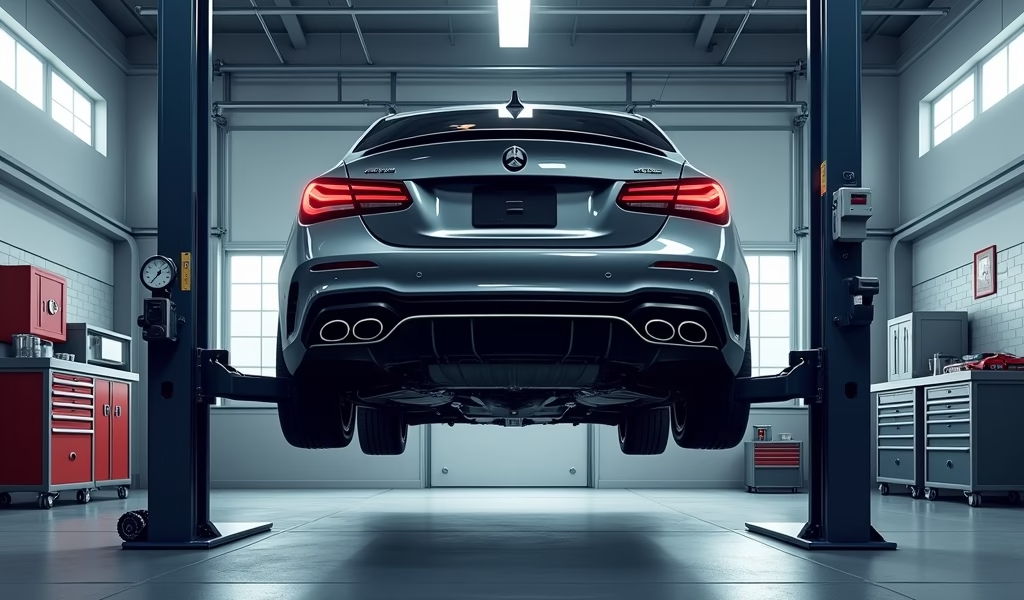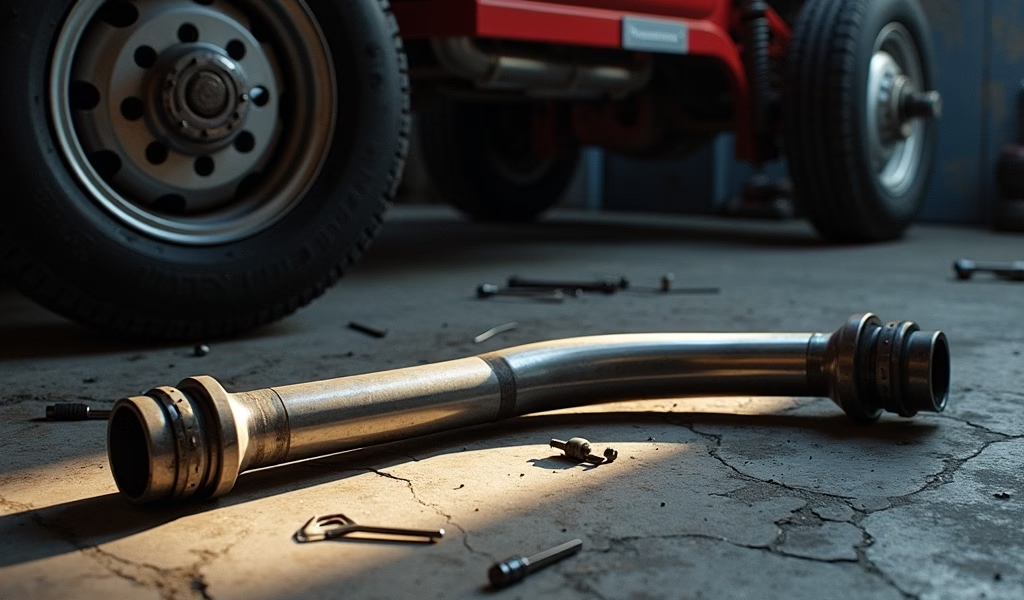Overview
This guide explains how to verify, diagnose, and correct axle tube alignment issues that can cause poor handling, vibrations, and premature tire wear in vehicles. The article covers measurement techniques using both basic and professional tools, interpretation of results, correction options ranging from professional straightening to replacement, and preventative maintenance strategies to maintain proper axle alignment.
Table of Contents
- Why Axle Tube Straightness Matters
- Common Causes of Bent Axle Tubes
- Signs of Axle Tube Misalignment
- Tools Needed for Verification
- Step-by-Step Verification Process
- Interpreting Your Measurements
- Correction Options
- DIY vs. Professional Repair
- Preventative Maintenance
- Conclusion
- Frequently Asked Questions
When it comes to vehicle performance, few things are as fundamental yet overlooked as axle tube straightness. As a master mechanic with 20 years in the field, I’ve seen countless vehicles suffering from poor handling, premature tire wear, and mysterious vibrations—all stemming from bent axle tubes.
Think of your axle tubes as your vehicle’s backbone. When they’re properly aligned, your car tracks true. When they’re bent, even slightly, the entire driving experience suffers. This comprehensive guide will walk you through verifying axle tube straightness, identifying problems, and determining the best solution for your vehicle.
Why Axle Tube Straightness Matters
Axle tube straightness isn’t just mechanical trivia—it’s fundamental to how your vehicle drives, handles, and wears. Straight axle tubes ensure your wheels maintain proper alignment with the road and with each other.
When axle tubes bend (even slightly), several problems cascade throughout your vehicle:
- Unpredictable handling and poor stability
- Uneven and accelerated tire wear
- Increased strain on drivetrain components
- Compromised safety during emergency maneuvers
- Reduced fuel efficiency due to increased rolling resistance
Many drivers mistakenly blame their tires or steering components when the true culprit is axle misalignment. I’ve seen customers save thousands by addressing the root cause rather than continually replacing parts that were merely symptoms of the problem.
Properly aligned axle tubes also help maintain optimal rear axle housing spread, which is critical for drivetrain longevity. The relationship between these components highlights why a holistic approach to axle health is essential.
Common Causes of Bent Axle Tubes
Axle tubes are robust components, but they can still bend under certain circumstances. Understanding these causes can help you prevent damage or identify when verification is needed:
- Impact events: Hitting curbs, deep potholes, or off-road obstacles
- Vehicle accidents: Even minor fender-benders can transfer force to axle components
- Overloading: Exceeding your vehicle’s weight rating stresses axle tubes
- Poor lifting techniques: Improper jacking points can bend components
- Previous improper repairs: Band-aid fixes often create long-term problems
Heavy-duty trucks and off-road vehicles are particularly susceptible to axle tube bending due to the extreme conditions they face. However, even family sedans can develop issues after years of normal city driving over deteriorating roads.
According to research from the Society of Automotive Engineers, as little as 2mm of axle tube deflection can create measurable negative effects on vehicle dynamics and component wear.

Signs of Axle Tube Misalignment
Before diving into verification, it helps to know if you might actually have an issue. Here are telltale signs that warrant axle tube inspection:
- Vehicle pulls to one side during normal driving or braking
- Uneven tire wear, particularly on the inside or outside edges
- Tires that cup or scallop (diagonal wear patterns)
- Steering wheel isn’t centered when driving straight
- Vehicle feels unstable at highway speeds
- Vibrations that increase with speed
- Wheels that appear to have different camber angles when viewed from behind
I recently worked on a Jeep Wrangler that had chewed through three sets of expensive all-terrain tires in under 30,000 miles. The owner had replaced ball joints, tie rods, and even the steering box. Turned out, a bent axle tube from an off-road adventure was the culprit all along.
If you’re experiencing these symptoms, don’t immediately assume your axle tubes are bent. However, do include axle tube straightness verification as part of your troubleshooting process, especially if conventional alignment doesn’t resolve the issues.
Tools Needed for Verification
Proper verification requires the right tools. While professional shops use sophisticated equipment, home mechanics can perform basic checks with accessible tools:
Basic Tools (DIY Friendly)
- Tape measure (preferably in millimeters for precision)
- String or mason’s line
- Carpenter’s level (24″ or longer)
- Jack stands (rated for your vehicle’s weight)
- Chalk or masking tape for marking reference points
- Plumb bob
- Notepad for recording measurements
Advanced Tools (Professional Grade)
- Dial indicators with magnetic bases
- Digital angle finder/protractor
- Trammel bars or axle alignment gauges
- Laser alignment tools
- Straight edge (precision machined)
- Feeler gauges
Don’t let a lack of professional tools discourage you. Many axle alignment issues can be identified with basic measurements. The key is consistency and methodical approach.
Even the most experienced hot rod builders often start with simple string-line checks before moving to more sophisticated measurements.
Step-by-Step Verification Process
Now let’s get into the verification process itself. I’ll outline a method that balances thoroughness with practicality:
Preparation
- Park your vehicle on a level, smooth surface (ideally a garage floor or concrete pad)
- Ensure tire pressures are correct and equal on all tires
- Clean the axle tubes, removing any dirt or debris
- Mark the center of the vehicle on both front and rear bumpers
Basic String Line Check
- Place jack stands under approved lifting points and raise the vehicle
- Run a string from the center mark on the front bumper to the center mark on the rear bumper
- Measure the distance from this centerline string to identical points on each axle tube (both left and right sides)
- Compare these measurements – they should be equal if the axle is straight
Measurement Points
Take measurements at these critical locations:
- At the outboard ends of each axle tube
- At the spring perch mounting points
- At the center section where the tubes meet the differential
- At any brackets or mounting points along the tubes
Rotational Alignment Check
- With the vehicle still raised, rotate the wheels and watch for wobble or runout
- Use a dial indicator (if available) against the brake rotor surface
- Check that both wheels rotate in the same plane
Document all measurements carefully. The pattern of discrepancies tells a story about what happened to your axle tubes and where they may be bent.
Remember that factory tolerances are typically very tight – differences of more than 1/8″ (3mm) between corresponding points often indicate an issue requiring attention.

Interpreting Your Measurements
Once you’ve collected your measurements, it’s time to analyze what they mean. Here’s how to interpret what you’ve found:
Understanding Tolerances
- Factory specs typically allow ±1/16″ (1.5mm) variation
- Differences of 1/8″ to 1/4″ (3-6mm) indicate minor misalignment
- Variations exceeding 1/4″ (6mm) suggest significant problems requiring correction
Common Measurement Patterns
Different patterns indicate different issues:
- Equal offsets on both ends: The entire axle has shifted but may still be straight
- Greater offset on one end: The axle is likely bent in a “sweep” pattern
- Central measurements off but ends aligned: The axle may have a “bow” in the middle
- Irregular measurements throughout: Multiple bends or complex damage
When assessing your results, consider that some factory axles have slight built-in offsets to compensate for driveline angles or suspension geometry. Consult your vehicle’s service manual for specific tolerance information when available.
As engine building professionals note, even small deviations in rotating or load-bearing components can create significant issues over time through amplification and harmonics.
Correction Options
If you’ve confirmed your axle tubes aren’t straight, you have several correction paths. The right choice depends on the severity of the problem, your budget, and your vehicle’s use case:
Straightening
For minor bends (less than 1/4″ deviation), professional straightening might be possible. This process involves:
- Careful heating of the bent area
- Application of controlled pressure using specialized jigs
- Gradual reshaping while constantly measuring alignment
- Final verification of straightness under load
Straightening is most viable for solid, heavy-duty axles. It’s less effective and not recommended for thin-walled or complex axle assemblies.
Replacement Options
- OEM Replacement: Factory-new axle assemblies offer perfect fitment but come at premium prices ($800-2,500)
- Remanufactured Units: Factory-rebuilt assemblies provide good quality at moderate cost ($500-1,200)
- Used Assemblies: Salvage yard axles offer budget solutions ($200-600) but require careful inspection
- Aftermarket Upgrades: Performance or heavy-duty replacements can provide improved durability ($700-3,000+)
For serious off-roaders or performance enthusiasts, an axle issue sometimes becomes the perfect excuse to upgrade to stronger components. Many manufacturers offer bolt-in axle assemblies with improved strength, better gear ratios, or locking differentials.
DIY vs. Professional Repair
Know your limits when dealing with axle tube issues. Here’s a realistic breakdown of what’s DIY-friendly and what’s best left to the pros:
DIY-Appropriate Tasks
- Basic straightness verification using string lines and measurements
- Documentation of symptoms and measurements
- Replacement of complete axle assemblies (for experienced home mechanics)
- Installation of aftermarket bolt-on upgrade assemblies
Professional-Level Work
- Precision measurement using specialized alignment equipment
- Axle tube straightening (requires specialized skills and tools)
- Welding or machining operations on axle components
- Complex integrations affecting other suspension components
I’ve seen too many DIY attempts at axle straightening go wrong. What looks like a simple bend often involves complex stresses that, when released improperly, create new problems. Professional axle shops have both the equipment and experience to address these issues safely.
If you do choose professional help, be sure to ask about warranty coverage on both parts and labor. Quality shops stand behind their axle work because they understand the safety implications.
Preventative Maintenance
An ounce of prevention is worth a pound of cure, especially with axle components. Here are strategies to keep your axle tubes straight and true:
Driving Habits
- Approach speed bumps and driveway transitions at an angle
- Reduce speed before encountering rough terrain
- Avoid bottoming out your suspension
- Be cautious when fully loaded, as weight amplifies impact forces
Regular Inspection
- Check for unusual tire wear patterns every 5,000 miles
- Inspect axle tubes visually during oil changes
- Pay attention to handling changes after impacts or off-road use
- Have alignment checked annually or after significant impacts
Off-Road Precautions
- Install appropriate skid plates to protect axle components
- Choose lines carefully to avoid high-centering or sudden drops
- Consider axle trusses for vehicles subjected to extreme conditions
- Upgrade to stronger axle components before pushing vehicles to extremes
Remember that your vehicle’s axle design reflects its intended use. Stock axles in passenger cars aren’t designed for off-road abuse, while purpose-built 4x4s have stronger components. Know your vehicle’s limits.
Conclusion
Axle tube straightness verification might seem like a specialized niche in the automotive world, but it’s actually a fundamental aspect of vehicle health that affects everything from safety to tire longevity. By understanding how to check for issues, interpret measurements, and choose appropriate corrections, you’re empowering yourself to make better decisions about your vehicle’s maintenance.
Whether you’re dealing with mysterious handling issues, excessive tire wear, or recovering from an off-road mishap, the knowledge in this guide provides a roadmap to diagnosis and resolution. Remember that small deviations in axle straightness create big effects on the road.
For most drivers, the verification process will provide peace of mind. For those who discover issues, addressing them promptly prevents the cascade of expensive problems that bent axle tubes inevitably create. Either way, you’re now equipped with professional-level knowledge about a critical vehicle system that many overlook.
Keep those axles straight, and your driving experience will remain true.
Frequently Asked Questions
How much does professional axle tube straightening cost?
Professional axle tube straightening typically costs between $300-800 depending on severity and vehicle type. Complex cases involving multiple bends or specialty vehicles may cost more.
Can I drive with slightly bent axle tubes?
Driving with bent axle tubes is possible but not recommended as it accelerates tire wear and compromises handling. The severity of the bend determines how unsafe the condition is.
Will a standard wheel alignment fix axle tube issues?
Standard wheel alignments cannot correct bent axle tubes. Alignment shops may adjust toe and camber to compensate temporarily, but the underlying issue remains.
How often should I verify axle tube straightness?
Verify axle tube straightness after any significant impact, when experiencing unusual handling, or when noticing uneven tire wear. For normal driving, annual checks are sufficient.
Can axle tubes bend without visible damage?
Yes, axle tubes can bend without showing visible damage. Metal can flex significantly before showing external signs, which is why measurement-based verification is essential.

